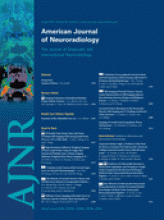Research ArticleBrainP
Open Access
Xenon-Enhanced Cerebral Blood Flow at 28% Xenon Provides Uniquely Safe Access to Quantitative, Clinically Useful Cerebral Blood Flow Information: A Multicenter Study
A.P. Carlson, A.M. Brown, E. Zager, K. Uchino, M.P. Marks, C. Robertson, G.P. Sinson, A. Marmarou and H. Yonas
American Journal of Neuroradiology August 2011, 32 (7) 1315-1320; DOI: https://doi.org/10.3174/ajnr.A2522
A.P. Carlson
A.M. Brown
E. Zager
K. Uchino
M.P. Marks
C. Robertson
G.P. Sinson
A. Marmarou

References
- 1.↵
- Latchaw RE,
- Yonas H,
- Pentheny SL,
- et al
- 2.↵
- 3.↵
- Vazquez Anon V,
- Aymard A,
- Gobin YP,
- et al
- 4.↵
- Mathis JM,
- Barr JD,
- Jungreis CA,
- et al
- 5.↵
- Gillard J,
- Graves M,
- Hatsukami T,
- et al.
- Carlson A,
- Yonas H
- 6.↵
- Webster MW,
- Makaroun MS,
- Steed DL,
- et al
- 7.↵
- Kitahara T,
- Yamashita T,
- Kashiwagi S,
- et al
- 8.↵
- Hughes RL,
- Yonas H,
- Gur D,
- et al
- 9.↵
- Carlson AP,
- Yonas H
- 10.↵
- 11.↵
- Fukui MB,
- Johnson DW,
- Yonas H,
- et al
- 12.↵
- Tarr RW,
- Johnson DW,
- Rutigliano M,
- et al
- 13.↵
- Reigel MM,
- Hollier LH,
- Sundt TM Jr.,
- et al
- 14.↵
- Hlatky R,
- Contant CF,
- Diaz-Marchan P,
- et al
- 15.↵
- 16.↵
- Latchaw RE,
- Yonas H,
- Darby JM,
- et al
- 17.↵
- 18.↵
- Okuchi K,
- Nagata K,
- Otsuka H,
- et al
- 19.↵
- 20.↵
- 21.↵
- 22.↵
- Gur D,
- Good WF,
- Herbert DL,
- et al
- 23.↵
- Yonas H,
- Smith HA,
- Durham SR,
- et al
- 24.↵
- Wolfson SK Jr.,
- Clark J,
- Greenberg JH,
- et al
- 25.↵
- Matsuda M,
- Lee H,
- Kuribayashi K,
- et al
- 26.↵
- Rumboldt Z,
- Huda W,
- All JW
- 27.↵
- Seifert H,
- Blass G,
- Leetz HK,
- et al
- 28.↵
- Gur D,
- Good WF,
- Wolfson SK Jr.,
- et al
- 29.↵
- 30.↵
- Nariai T
- 31.↵
- Valadka AB,
- Hlatky R,
- Furuya Y,
- et al
- 32.↵
- Preckel B,
- Weber NC,
- Sanders RD,
- et al
- 33.↵
- Rossaint R,
- Reyle-Hahn M,
- Schulte Am Esch J,
- et al
- 34.↵
- 35.↵
- 36.↵
- Behrens PF,
- Ostertag CB,
- Warnke PC
- 37.↵
- Sesay M,
- Tanaka A,
- Dousset V,
- et al
- 38.↵
- Yonas H,
- Grundy B,
- Gur D,
- et al
- 39.↵
- Yonas H,
- Pindzola RP,
- Johnson DW
- 40.↵
- Harrod CG,
- Bendok BR,
- Batjer HH
- 41.↵
- Krol AL,
- Dzialowski I,
- Roy J,
- et al
- 42.↵
- 43.↵
- 44.↵
- 45.↵
- Shellock FG,
- Spinazzi A
- 46.↵
In this issue
Advertisement
A.P. Carlson, A.M. Brown, E. Zager, K. Uchino, M.P. Marks, C. Robertson, G.P. Sinson, A. Marmarou, H. Yonas
Xenon-Enhanced Cerebral Blood Flow at 28% Xenon Provides Uniquely Safe Access to Quantitative, Clinically Useful Cerebral Blood Flow Information: A Multicenter Study
American Journal of Neuroradiology Aug 2011, 32 (7) 1315-1320; DOI: 10.3174/ajnr.A2522
0 Responses
Xenon-Enhanced Cerebral Blood Flow at 28% Xenon Provides Uniquely Safe Access to Quantitative, Clinically Useful Cerebral Blood Flow Information: A Multicenter Study
A.P. Carlson, A.M. Brown, E. Zager, K. Uchino, M.P. Marks, C. Robertson, G.P. Sinson, A. Marmarou, H. Yonas
American Journal of Neuroradiology Aug 2011, 32 (7) 1315-1320; DOI: 10.3174/ajnr.A2522
Jump to section
Related Articles
Cited By...
This article has been cited by the following articles in journals that are participating in Crossref Cited-by Linking.
- Hrvoje Lusic, Mark W. GrinstaffChemical Reviews 2013 113 3
- Yajur Shukla, Andrew Wheatley, Miranda Kirby, Sarah Svenningsen, Adam Farag, Giles E. Santyr, Nigel A.M. Paterson, David G. McCormack, Grace ParragaAcademic Radiology 2012 19 8
- Xiang Kong, Hui Xue Sheng, Guang Ming Lu, Felix G. Meinel, Kevin T. Dyer, U. Joseph Schoepf, Long Jiang ZhangAmerican Journal of Roentgenology 2014 202 2
- Elham Rostami, Henrik Engquist, Per EnbladFrontiers in Neurology 2014 5
- Miranda Kirby, Alexei Ouriadov, Sarah Svenningsen, Amir Owrangi, Andrew Wheatley, Roya Etemad-Rezai, Giles E. Santyr, David G. McCormack, Grace ParragaPhysiological Reports 2014 2 7
- Li Tian, Linfeng Lu, James Feng, Marites P. MelanconActa Pharmaceutica Sinica B 2018 8 3
- Edward G. Meloni, Timothy E. Gillis, Jasmine Manoukian, Marc J. Kaufman, Patrizia CampolongoPLoS ONE 2014 9 8
- Alexander Dobrovolsky, Thomas E. Ichim, Daqing Ma, Santosh Kesari, Vladimir BoginJournal of Translational Medicine 2017 15 1
- Henrik Engquist, Elham Rostami, Elisabeth Ronne-Engström, Pelle Nilsson, Anders Lewén, Per EnbladNeurocritical Care 2018 28 2
- Manoj P. Dandekar, Tao Peng, David D. McPherson, Joao Quevedo, Jair C. Soares, Shao-Ling HuangProgress in Neuro-Psychopharmacology and Biological Psychiatry 2018 86
More in this TOC Section
Similar Articles
Advertisement











